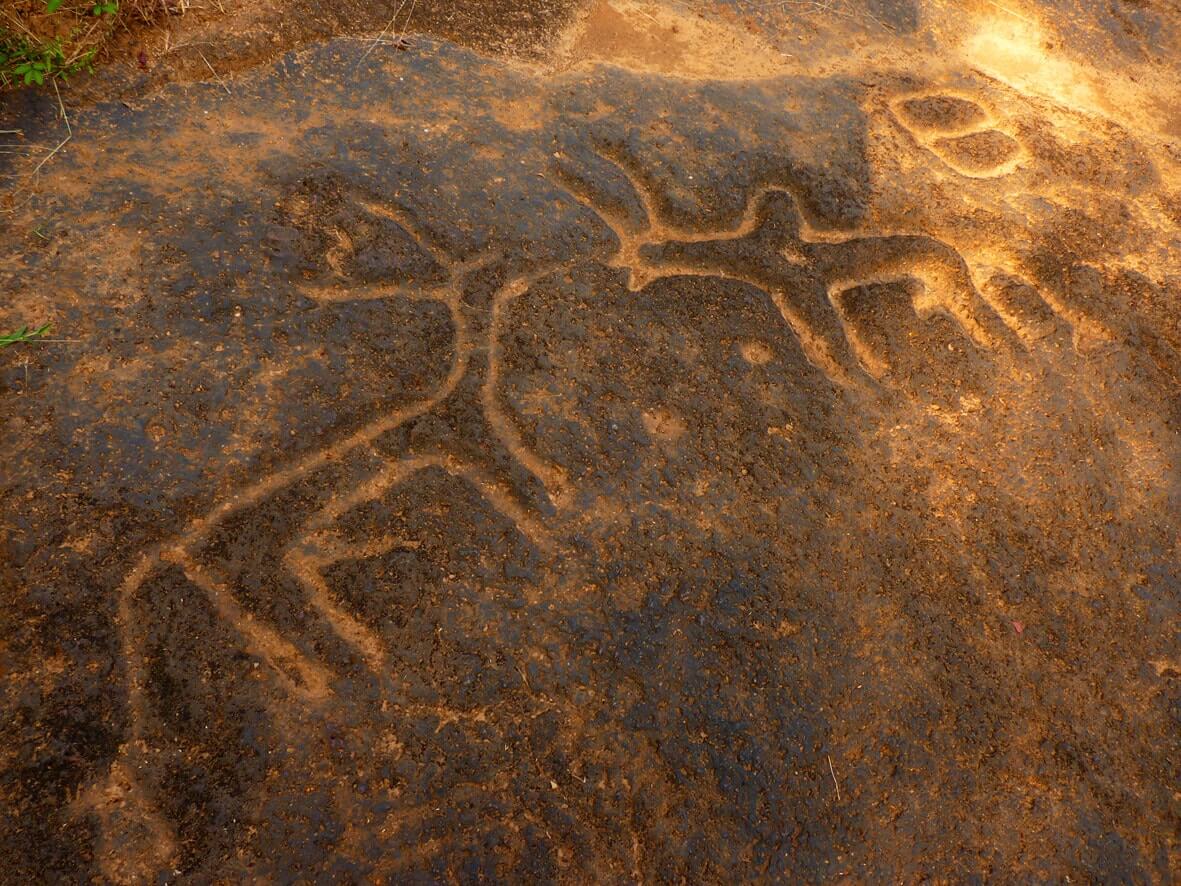Usgalimal Rock Carvings The mysterious rock carvings of Usgalimal were discovered in 1993 by the villagers of Usgalimal, which is situated at about 16 kms south of Rivona in the Sanguem taluka in south Goa. The villagers informed the archaelogists about the traces of pre-historic settlement who were led outside the village to a bend in the river Kushawati. Here they saw a shelf of laterite, which due to the monsoon floods was covered in a layer of mud that was swept downstream. Once they cleared this it was seen that the rock had carvings of around one hundred distinct figures, which included images of Bulls, spirals, lines and human figures. The Usgalimal rock carvings is now one of the most important prehistoric sites in western India as they are thought to date between 20 and 30 thousand years ago from the Upper Paleolithic or Mesolithic eras. Now a days one can easily get to the carvings at Usgalimal as a board has been erected by the ASI along the roadside for advertisement. This makes it easier to get there as the site is hidden behind an old iron mine and it is also situated quite far away from the coast. The Viceroy’s Arch The Viceroy’s Arch erected in 1599 by Viceroy Francisco da Gama was once the main street for entering Old Goa.
It was built as a memorial to the achievements of Vasco da Gama, the famous explorer. Francisco da Gama was the great grand son of Vasco da Gama and was the governor of Goa from 1597 to 1600. In 1954 the arch was reconstructed with Vasco da Gama’s statue on the river side and the statue of St. Catherine on the other side. A road leads to the Mandovi River from the St. Cajetan Church and passes through the Viceroy’s Arch. It is also known to have been one of the gates of the Adil Shah Palace and is made of laterite. Devil’s Canyon Devil’s Canyon also known as “Devcharacho kond” in Konkani, is a picturesque river gorge near Molem situated in a beautiful patch of the jungle where the river flows with great turbulence and cuts the deep gorge into solid rock. It is suicidal for swimmers due to the slippery rocks, strong undercurrents and unfathomed depth. The story about this place is that everyday a villager used to ask the canyon’s resident devil for fish by telling him that he had to entertain some guests. The devil who was curious, one day after following the villager saw him munching on the fish himself. He cursed that from then onward no one will be able to catch fish in the canyon, as he was furious at that time. Till today the curse still stands.
The Devil’s Canyon situated near Molem at the Bhagwan Mahaveer Sanctuary is now a famous spot in Goa. In its jungles one can see some rare sightings of Black Panther and while here one can also visit the Tambdi Surla Temple that is situated nearby. The spot can also visited while on the way to or from the famous Dudhsagar waterfalls. British cemetery The military or the British cemetery was built in Goa in 1802 by the British. It is considered to be more than 180 years old and is the only reminder of the British occupation of the territory of Goa during the Napoleonic period. During the Napoleonic wars from 1799 to 1813, the British military cemetery was built to serve the purpose of a British garrison of Rs.10,000 men who were stationed at Fort Cabo to prevent Goa from falling into French hands. The cemetery has 56 gravestones and 47 tombstones, the earliest that date to 1808 and the last to 1912. It can be reached by taking the road connecting the National Institute of Oceanography (NIO) with the Raj Bhawan. Near the British cemetery one can visit the Cabo Raj Bhavan also known as the Governor’s Palace, which is the official residence of the governor of Goa. Also one can visit the Our Lady of Cabo church that is situated nearby.


